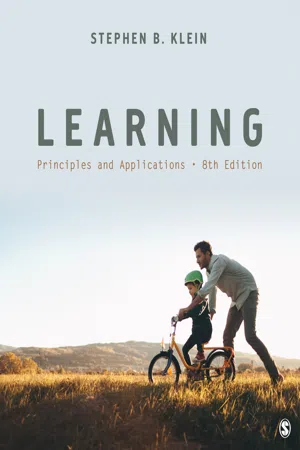Biological Sciences
Learned Behavior in Animals
Learned behavior in animals refers to actions or responses that are acquired through experience and interaction with the environment, rather than being instinctual or innate. This can include skills such as problem-solving, social behaviors, and foraging techniques. Learned behaviors can vary widely among different species and can be influenced by factors such as environmental conditions, social interactions, and individual experiences.
Written by Perlego with AI-assistance
Related key terms
5 Key excerpts on "Learned Behavior in Animals"
- Julie Shaw, Debbie Martin(Authors)
- 2014(Publication Date)
- Wiley-Blackwell(Publisher)
This chapter discusses some of the innate and environmental effects on learning and different ways that animals learn. Behavior modification techniques using these types of learning are defined. In Chapter 8, the practical uses of these techniques are discussed. No book chapter can capture completely the complexity of animal learning. Students should read a variety of sources and use critical thinking to create their own ideas on how animals learn.- Students should read a variety of sources and use critical thinking to create their own ideas on how animals learn.
Genetics and learning
“Genetics has profound effects on an animal's behavior.” (Grandin and Deesing, 1998, p. 24). Different species and breeds of animals perform species- and breed-specific behaviors because of differences in their genetic codes. Lorenz (1965) spent many years studying innate behaviors he called fixed action patterns. Animals performed these behaviors or behavioral chains after being exposed to a specific stimulus in their environment called a sign stimulus. For example, parent birds feed baby birds that display the red interior of their mouths. Cats exhibit a pattern of predatory behavior after seeing or hearing a prey animal. Behaviors can be thought of as being on a continuum from innate to learned, with behaviors being either innate, learned, or a combination of the two (Lorenz, 1965). Behaviors generally believed to be reflexes can be affected by the environment through chemical or contextual input. Environmental influences do not always mean learning; they can be nutritional or chemical influences.- Behaviors can be thought of as being on a continuum from innate to learned, with behaviors being either innate, learned, or a combination of the two (Lorenz, 1965).
Although it would be orderly for all behaviors to be adaptive, this cannot be the case. The basis for evolution is a large number of diverse offspring from which the environment selects the fittest individuals using natural selection (Darwin, 1859). Skinner (1966) discussed how behaviors may appear, although they are counterproductive for an animal. These behaviors are less likely to be passed on to future generations, but they may be passed on if the animal has enough adaptive behaviors to survive long enough to reproduce. It is this capability, reproduction, which judges whether the animal is fit, as in the survival of the fittest, not aggression and not hierarchical placement.- eBook - ePub
- Eliot Hearst(Author)
- 2019(Publication Date)
- Routledge(Publisher)
Recent developments have not been encouraging to the view that the study of learning in animals is an important source of principles relevant to human behavior. Since the 1950s there has been a burgeoning of subdisciplines focused on different aspects of human behavior such as language learning, cognitive development, memory, information processing, reasoning, and so on. As these subdisciplines mature, they develop their own specialized experimental paradigms and their own theoretical issues. The psychology of animal learning has become increasingly isolated from the concerns of these subdisciplines. This isolation from human psychology, coupled with the challenge from the ethological perspective and cognitive psychology, has led many psychologists in the tradition to reexamine the question of how learning in lower animals should be studied so as to make the greatest contribution to our understanding of human behavior.I would like to comment on four approaches to the study of animal learning. They imply different, although certainly not mutually exclusive, answers to the question of what the study of animal learning should be about.The first approach centers on the further development of an associative theory of learning. Progress is being made toward a more adequate theory of associative processes in conditioning. In recent years, more has been learned about contingency, prediction, and selectivity in signaling. There has been some progress toward understanding why animal behavior sometimes appears to be cognitive, changing in accordance with inference-like rules, and is at other times apparently not at all cognitive, changing only by virtue of repeated experience with reinforcement or nonreinforcement.Will continued efforts to develop an associative theory of animal learning lead to general principles of learning applicable to human behavior? If those who argue for a high degree of evolutionary specialization in learning are correct, general principles will not emerge from the study of “representative” organisms in “representative” conditioning experiments.The proponents of the view that there is a general learning process have responded to the specialization argument. They have pointed out that even in the prime examples of specialized learning, such as taste aversion, general principles of association may be found (see Revusky, 1977 for a defense of this view). For example, a novel CS conditions more readily than a preexposed CS in taste aversions, just as it does in other instances of conditioning. Moreover, the proponents of a general learning process are not convinced that the apparent specializations will prove to be beyond the reach of a more fully developed theory of associative learning. Perhaps general principles for “belongingness” (especially effective combinations of stimuli, responses, and reinforcers) can be found. The similarity of CS and US, for example, appears to favor association, and it might be one of the principles of belongingness (Testa & Ternes, 1977). - eBook - ePub
Comparative Psychology for Clinical Psychologists and Therapists
What Animal Behavior Can Tell Us about Human Psychology
- Daniel C. Marston, Terry L. Maple(Authors)
- 2016(Publication Date)
- Jessica Kingsley Publishers(Publisher)
2 LEARNING AND MEMORY IntroductionLearning and being able to remember what you have learned are two of the most ancient brain processes in animals. Learning not to do something that hurts is arguably one of the most adaptive responses in animal behavior. Even very simple organisms, such as earthworms, are capable of learning to avoid and escape aversive stimuli (Wilson et al. 2014). While there are obvious differences between humans and earthworms, studying the processes of learning and memory in nonhuman species has provided a tremendous amount of insight into how those processes work in the human brain and how they can shape human behavior. In this chapter, we look at learning and memory in ways that can be helpful for therapists and counselors. This involves not only addressing learning and memory in very general ways, but also delving into the specific types of learning and memory processes that are particularly important for creating behavioral changes.Definitions Learning In his widely read textbook on learning and memory, Domjan (2015, p.14) provides a general definition of learning: Learning is an enduring change in the mechanism of behavior involving specific stimuli and/or responses that result from prior experiences with those or similar stimuli and responses.Based on this definition, there are two main components of learning. First, learning must result in a relatively permanent change in behavior. If a college student crams for an exam and manages to pass, we do not consider that as learning since the material will likely be forgotten (McIntyre and Munson 2008). Second, learning is the result of past experience. That is, you must get some sort of new information before you can learn. This information could take many forms, including: failing at a task and learning from your mistakes; listening to a lecture or reading a book; watching someone else perform the task; or any number of other methods. But, you generally need some new knowledge or experience for learning to occur. - eBook - ePub
The Epigenesis of Mind
Essays on Biology and Cognition
- Susan Carey, Rochel Gelman(Authors)
- 2014(Publication Date)
- Psychology Press(Publisher)
I BIOLOGICAL CONTRIBUTIONS TO COGNITIONPassage contains an image
C. R. Gallistel1 Lessons From Animal Learning for the Study of Cognitive Development University of California, Los AngelesAnn L. BrownUniversity of California, BerkeleySusan CareyMassachusetts Institute of TechnologyRochel GelmanUniversity of California, Los AngelesFrank C. KeilCornell UniversityWhy open a book on cognitive development with a chapter on animal learning? It is not to argue that an account of cognitive development should use animal models of learning. Rather, it is to take advantage of developments in this area that provide insight into the question of how to characterize cognitive development. We argue that any account of cognitive development is incomplete if it attempts to explain both the what and how of learning solely in terms of general processes—be they associations, prototype abstraction, hypothesis testing, induction, analogical reasoning, assimilation, generalization, or differentiation. We argue that there are reasons for also postulating domain-specific determinants of the nature of cognitive structures. These determinants guide leaning, creating structures with their own rules of organization. These ideas about cognitive development have been in the air for sometime; what we offer here is a fleshing out of them. We are emboldened to do so in part because of what we have learned from considering cases of learning in species other than the human. The message of this chapter is that much learning in animals is best thought of as the product of behavioral mechanisms with elaborated internal structure that have evolved to guide learning of species-relevant features of the environment.Specification of the conditions under which learning occurs has been a central goal of experimental psychology since its inception as a natural science. A major research agenda from this tradition has been to delineate general laws of learning that hold across species and problems (domains). It was this fundamental commitment to general laws that led major learning theorists (e.g., Thorndike, Hull, Skinner, and Watson) to the behavior of man with laws derived from animal models. Indeed, it has been argued that the main agenda of experimental animal learning was not to explain animal learning but to understand human learning (Schwartz, 1981). From this position, animal-specific solutions are not only irrelevant, they are a positive nuisance in the march towards understanding the general laws of learning that explain human behavior. Animal models, if they are to elucidate human behavior, must assume commonality. - eBook - ePub
Learning
Principles and Applications
- Stephen B. Klein(Author)
- 2018(Publication Date)
- SAGE Publications, Inc(Publisher)
The “general laws of learning” view we just described assumes that learning is the primary determinant of how an animal acts. According to this approach, learning functions to organize reflexes and random responses so that an animal can effectively interact with the environment. The impact of learning is to allow the animal to adapt to the environment and thereby survive. However, the quote presented at the beginning of this section provides a different perspective on the impact of learning on behavior. Rather than proposing that learning organizes behavior, Garcia and Garcia y Robertson (1985) argued that the function of learning is to enhance existing organization rather than to create a new organization. Many psychologists (Garcia & Garcia y Robertson, 1985; Hogan, 1989; Timberlake, 2001) have suggested that learning modifies preexisting instinctive systems rather than constructs a new behavioral organization; we look at this idea next.William Timberlake’s (2001; Timberlake & Lucas, 1989) behavior systems approach offers an alternative to the general laws of learning view. According to Timberlake, an animal possesses instinctive behavior systems such as feeding, mating, social bonding, care of young, and defense. Each instinctive behavior system is independent and serves a specific function or need within the animal. Figure 8.1 shows the predatory subsystem of the feeding system in rats.As the figure shows, there are several components of the animal’s predatory response. The predatory sequence begins with the rat in a general search mode. The search mode causes the rat to show enhanced general searching, which leads to greater locomotion and increased sensitivity to spatial and social stimuli that are likely to bring the rat closer to food. The increased locomotion and greater sensitivity to the environment lead the rat to notice a small moving object in the distance as its prey. Once the prey is close, the rat shifts from a general search mode to a focal search mode. The focal search mode causes the rat to engage in a set of perceptual-motor modules related to capturing and subduing its prey. Once the prey is captured, the rat shifts to a handle or consume mode, which elicits the biting, manipulating, chewing, and swallowing involved in the consumption of the prey. This complex instinctive predatory behavior system allows the animal to find and consume the nutrients it needs to survive.
Learn about this page
Index pages curate the most relevant extracts from our library of academic textbooks. They’ve been created using an in-house natural language model (NLM), each adding context and meaning to key research topics.




